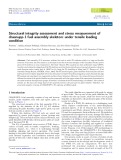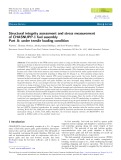
REGULAR ARTICLE
Structural integrity assessment and stress measurement
of CHASNUPP-1 fuel assembly
Part A: under tensile loading condition
Waseem
*
, Ghulam Murtaza, Ashfaq Ahmad Siddiqui, and Syed Waseem Akhtar
Directorate General Nuclear Power Fuel, Pakistan Atomic Energy Commission, PO Box No. 1847, 44000 Islamabad, Pakistan
Received: 10 September 2015 / Received in final form: 26 November 2015 / Accepted: 28 January 2016
Published online: 8 April 2016
Abstract. Fuel assembly of the PWR nuclear power plant is a long and flexible structure. This study has been
made in an attempt to find the structural integrity of the fuel assembly (FA) of Chashma Nuclear Power Plant-1
(CHASNUPP-1) at room temperature in air. The non-linear contact and structural tensile analysis have been
performed using ANSYS 13.0, in order to determine the fuel assembly (FA) elongation behaviour as well as the
location and values of the stress intensity and stresses developed in axial direction under applied tensile load of
9800 N or 2 g being the fuel assembly handling or lifting load [Y. Zhang et al., Fuel assembly design report,
SNERDI, China, 1994]. The finite element (FE) model comprises spacer grids, fuel rods, flexible contacts
between the fuel rods and grid’s supports system and guide thimbles with dash-pots and flow holes, in addition to
the spot welds between spacer grids and guide thimbles, has been developed using Shell181, Conta174 and
Targe170 elements. FA is a non-straight structure. The actual behavior of the geometry is non-linear due to its
curvature or design tolerance. It has been observed that fuel assembly elongation values obtained through FE
analysis and experiment [SNERDI Tech. Doc., Mechanical strength and calculation for fuel assembly, Technical
Report, F3.2.1, China, 1994] under applied tensile load are comparable and show approximately linear behaviors.
Therefore, it seems that the permanent elongation of fuel assembly may not occur at the specified load. Moreover,
the values of stresses obtained at different locations of the fuel assembly are also comparable with the stress values
of the experiment determined at the same locations through strain gauges. Since the results of both studies
(analytical and experimental) are comparable, therefore, validation of the FE methodology is confirmed. The
stress intensity of the FE model and maximum stresses developed along the guide thimbles in axial direction are
less than the design stress limit of the materials used for the grid [ASTM, Standard specification for precipitation
hardening nickel alloy (UNSN07718) plate, sheet, and strip for high temperature service, B 670-80, USA, 2013],
fuel rod [ASTM, Standard specification for wrought zirconium alloy seamless tubes for nuclear reactor fuel
cladding, B 811-02, USA, 2002] and the guide thimble [ASTM, Standard specification for seamless stainless steel
mechanical tubing, A 511-04, USA, 2004]. Therefore, the structural integrity criterion of CHASNUPP-1 fuel
assembly is fulfilled safely at the specified tensile load.
1 Introduction
CHASNUPP-1 fuel assembly consists of a 15 15 square
array of fuel rods, spacer grids, guide thimbles, instrumen-
tation tube, and top and bottom nozzles. The 3D model of
fuel assembly containing 20 guide thimbles, 204 fuel rods
and an instrumentation tube in conjunction with the 8
spacer grids and top and bottom nozzles, has been
developed using the Inventor software, and is shown in
Figure 1.
In fuel assembly, fuel rods are held by spacer grids
supports system (springs and dimples) to maintain rod-to-
rod centerline spacing along the entire length of fuel
assembly [1]. The material of top and bottom nozzles,
instrumentation tube and guide thimbles is SS-321,
whereas spacer grids and fuel rod cladding are made up
of Inconel-718 and Zircaloy-4, respectively.
The fuel assembly of pressurized water reactor (PWR)
bears a variety of loads, such as tensile, compressive,
bending, torsional, impact, etc., while undergoing through
handling, shipping and reactor operation. The structural
strength of the fuel assembly is supplied by the skeleton of
the fuel assembly.
* e-mail: wazim_me@hotmail.com
EPJ Nuclear Sci. Technol. 2, 18 (2016)
©Waseem et al., published by EDP Sciences, 2016
DOI: 10.1051/epjn/2016008
Nuclear
Sciences
& Technologies
Available online at:
http://www.epj-n.org
This is an Open Access article distributed under the terms of the Creative Commons Attribution License (http://creativecommons.org/licenses/by/4.0),
which permits unrestricted use, distribution, and reproduction in any medium, provided the original work is properly cited.






















